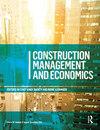解读建筑项目中BIM应用实践的动态
IF 3.3
Q2 BUSINESS
引用次数: 0
摘要
在过去的二十年里,思想领袖将建筑信息模型(BIM)定位为改变建筑、工程和施工(AEC)行业的驱动力。然而,意想不到的BIM使用实例已经浮出水面,项目经常中途从BIM转向混合甚至仅仅是2D实践。哪些技术使用条件导致了这些基于实践的对BIM使用的拒绝,以及这些拒绝是如何发生的,这些都没有得到充分的探索,使得BIM不能在项目中充分发挥作用。为了填补这一空白,我们使用结构理论作为理论视角来分析BIM和项目团队之间的互动,并探索三种技术使用条件(解释性、技术性和制度性)如何影响互动,最终形成技术使用实践。具体来说,选择了案例研究方法。研究小组参加了一个项目两年,收集会议观察,并进行调查和访谈,以跟踪在项目过程中技术使用条件发生变化的综合项目环境中出现的和定位的BIM使用实践。我们分析了这三种技术使用条件如何以不同的方式影响BIM与项目团队之间的互动,以及这些影响如何在不同的项目阶段发生变化。我们得出的结论是,持续使用BIM需要项目组织与BIM特征保持一致,并在实践变化中与自上而下和自下而上的投资保持一致,这包括激励高级管理层在持续的项目团队、个人能力培训和早期规划中进行投资。关键词:建筑信息模型;结构理论;技术在实践中的应用;数据可用性声明支持本研究结果的数据可应通讯作者YH的要求提供。由于其中包含的信息可能会损害研究参与者的隐私,因此这些数据不会公开。本文章由计算机程序翻译,如有差异,请以英文原文为准。
Decoding the dynamics of BIM use practice in construction projects
AbstractOver the past two decades, thought leaders positioned Building Information Modeling (BIM) as a driver to change the Architecture, Engineering, and Construction (AEC) industry. However, instances of unexpected BIM use have surfaced, with projects often shifting from BIM to hybrid or even solely 2D practices midway. What technology use conditions cause these practice-based rejections of BIM use and how these happen have not been fully explored and make BIM cannot fully play its role in a project. To fill this gap, we use structuration theory as a theoretical lens to analyze the interactions between BIM and project teams and explore how three technology use conditions, (interpretive, technological, and institutional), impact the interactions, which finally shape technology use practices. Specifically, a case study method has been selected. The research team attended a project for two years, collected meeting observations, and conducted surveys and interviews to track the emergent and situated BIM use practice in an integrated project setting with technology use conditions that changed over the course of the project. We analyzed how the three technology use conditions impacted the interactions between BIM and project teams in different ways and how these impacted change in different project phases. We conclude that the sustained use of BIM requires the alignment of project organizations with BIM features and alignment with both top-down and bottom-up investment in practice change, which includes motivation for senior management investment in a sustained project team, in individual capability training, and in early planning.Keywords: Building information modelingstructuration theorytechnology-in-practicepractice lens Disclosure statementThere are no relevant financial or non-financial competing interests to report.Data availability statementThe data that support the findings of this study are available on request from the corresponding author, YH. The data are not publicly available due to its containing information that could compromise the privacy of research participants.
求助全文
通过发布文献求助,成功后即可免费获取论文全文。
去求助
来源期刊

Construction Management and Economics
BUSINESS-
CiteScore
7.50
自引率
14.70%
发文量
58
期刊介绍:
Construction Management and Economics publishes high-quality original research concerning the management and economics of activity in the construction industry. Our concern is the production of the built environment. We seek to extend the concept of construction beyond on-site production to include a wide range of value-adding activities and involving coalitions of multiple actors, including clients and users, that evolve over time. We embrace the entire range of construction services provided by the architecture/engineering/construction sector, including design, procurement and through-life management. We welcome papers that demonstrate how the range of diverse academic and professional disciplines enable robust and novel theoretical, methodological and/or empirical insights into the world of construction. Ultimately, our aim is to inform and advance academic debates in the various disciplines that converge on the construction sector as a topic of research. While we expect papers to have strong theoretical positioning, we also seek contributions that offer critical, reflexive accounts on practice. Construction Management & Economics now publishes the following article types: -Research Papers -Notes - offering a comment on a previously published paper or report a new idea, empirical finding or approach. -Book Reviews -Letters - terse, scholarly comments on any aspect of interest to our readership. Commentaries -Obituaries - welcome in relation to significant figures in our field.
 求助内容:
求助内容: 应助结果提醒方式:
应助结果提醒方式:


